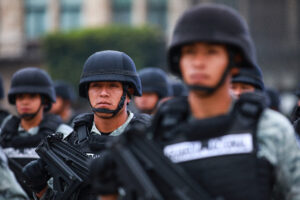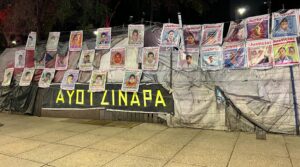The creation of a national gendarmerie, or gendarmería, forms a principle element of Mexican President Enrique Peña Nieto’s security strategy, and its establishment has already been agreed upon by Mexico’s principal political parties in the Pact for Mexico. More than two months into the new administration, Manuel Mondragón y Kalb, head of Mexico’s newly created National Commission on Security (Comisión Nacional de Seguridad), finally provided details on this new force during his February 25 confirmation hearing. While the government has not yet defined the gendarmerie’s primary responsibilities—such as whether its role will consist of reacting to or preventing crime—what is clear is that its members will come from the Mexican military. Mondragón stated that the gendarmerie will be operational by the end of 2013 and that the first group will be composed of 10,000 members of the military from Mexico’s Ministry of Defense (Secretaría para la Defensa Nacional, SEDENA) and the Ministry of the Navy (Secretaría de la Marina, SEMAR). Although Peña Nieto’s administration has touted the gendarmerie as part of the solution to Mexico’s security problems, there are several potential dangers in creating a new federal security force staffed by soldiers, including the further militarization of public security in Mexico and the potential for widespread human rights violations against the population.
By establishing another federal security force made up of elements with primarily military training, Peña is following in the footsteps of his predecessors to militarize public security in Mexico. Since the government of former president Ernesto Zedillo (1994-2000), every Mexican president has expanded the use of the armed forces in counter-drug operations and their role in civilian institutions and public security bodies. For example, when Zedillo established the Federal Preventative Police (Policía Federal Preventiva, PFP) in 1999, a little over 5,000 military personnel—about half the total force—were hired to serve in allegedly temporary positions until enough new civilian agents could be selected and trained. However, throughout the PFP’s existence, the military continued to have a strong presence within the force, and the number of military personnel in its ranks actually increased over time, particularly during the Fox government.* Likewise, while former president Calderón originally affirmed that the use of the military in public security was temporary and would last only until the federal police could fully assume their responsibilities, at the end of his government the military still had a lead role in operations to combat organized crime.
The continued use of members of the military in public security tasks during the Peña government will further consolidate the Mexican military’s role in public security and erase any illusion that this role is indeed temporary. A reliance on militarized bodies, even under civilian leadership, also may be at the expense of increased efforts to strengthen the civilian police forces. So far there has been no indication that in the medium to long term the members of the national gendarmerie will be drawn from civilian law enforcement bodies.
It is worth noting that unlike the model that the U.S. government has promoted in Latin American countries (including Mexico), U.S. law strongly restricts our military from carrying out law enforcement roles in the country, and for good reason—the police and the military are not interchangeable bodies. Military forces are trained for combat situations in which force is used to overwhelm an armed enemy. Police are a civilian corps, trained to address threats to public security while using the least amount of force possible and to address crime with the cooperation of the people. There are inherent risks in having military-trained forces in close contact with the civilian population; a clear and sobering example of this reality is the fact that between 2007 and 2012, 20 civilians (including several children) were killed by Mexican soldiers’ opening fire on vehicles that failed to stop at checkpoints. In the case of the gendarmerie, Mondragón told the Senate that the force will be under a strict military discipline system and that the corps would receive police instruction to complement their military training. It is particularly concerning that the predominantly military training of this force may be contrary to its responsibilities, particularly if it becomes a community police force (policía de proximidad) that addresses crimes under the states’ jurisdiction (fuero común), as Mondragón suggested at his confirmation hearing.
In addition to the potential harm caused by the increased militarization of public security, the Mexican military’s dismal human rights record does not bode well for the future of the gendarmerie. During the Calderón government, and as a result of the deployment of the military in counter-drug operations, Mexico’s National Human Rights Commission (Comisión Nacional de Derechos Humanos, CNDH) saw a five-fold increase in complaints of human rights violations by members of the Mexican army, rising to 1,503 in 2012. The Mexican navy also saw complaints skyrocket as its forces were increasingly used in operations in the interior of the country; while fewer in number than those related to the army, navy-related complaints rose from 31 in 2007 to 418 in 2012. These violations include documented cases of torture, extrajudicial execution, arbitrary detention, and enforced disappearance. The failure to investigate and prosecute the soldiers responsible for these abuses—SEDENA reported in October 2012 that since 2006 only 38 soldiers had been sentenced by military courts for human right abuses—has also facilitated their persistence. Even with President Peña’s expressed commitment to improve respect for human rights in Mexico, from December 1, 2012 to February 26, 2013, the CNDH received 257 complaints of abuse by Mexican soldiers.
In its favor, the gendarmerie will be under civilian control and civilian jurisdiction. However, the military’s human rights record clearly points to the need for any security force composed of Mexican soldiers to have strong internal and external accountability mechanisms. Otherwise, this new force may commit the same pattern of abuse of the population it is meant to protect that we have seen from the Mexican military in recent years. And a lack of accountability for human rights violations will also mean a lack of accountability for corruption and other types of crimes within the force.
*For example, in his first few years in office, Fox transferred eight entire army units and 1,600 members of several navy battalions to the PFP.


